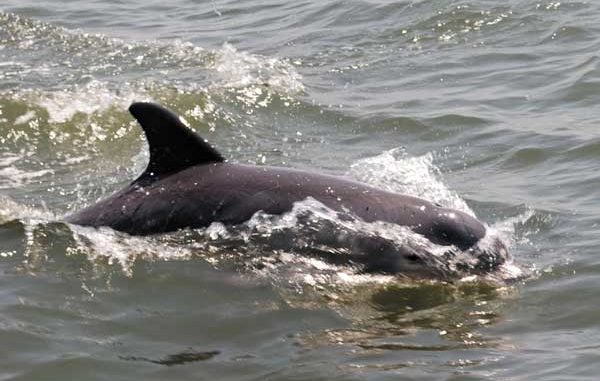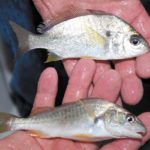
Two of Louisiana’s heavy hitters for springtime spawning bass are also loaded with publicly available ducks this time of year.
Fishermen often see porpoises (properly called bottlenose dolphins) breaking water near them while they are fishing. Many fishermen feel that porpoises scare fish away. A minority feel that porpoises go where the fish are, so fishing around porpoises is good.Everyone, though, wonders what they eat, and some suspect that they have bellies full of speckled trout.
In the late 1980s and early 1990s, scientists collected 234 stomachs form dead, stranded bottlenose dolphins in the Gulf and Florida east coast. Of these stomachs, 108 had food in them and 76 were analyzed for contents.
Even when the food animals in the stomachs were digested, many fishes’ otoliths (ear bones), squid beaks and shrimp spines and tail flippers were left behind. Each fish species has its own distinctive otolith, so they can be used to identify the species eaten.
In the study, finfish were found in 99 percent of the stomachs that contained food, squid in 37 percent and shrimp in 15 percent. The most commonly found food items were silver perch (a small, silvery fish similar to croaker), Atlantic croakers, sand seatrout (white trout), mullets, small squid and spots (sand diggers), each of which occurred in more than 20 percent of the stomachs.
Fishes of the drum family were found in 60.5 percent of the stomachs, and represented 78.4 percent of all identified fish. Most fish eaten were bottom-dwellers (drum, croakers, seatrout, toadfishes, midshipmen), but surface dwellers (mullets, herring) and open-water fish (jacks, bluefish, cutlassfish) were also eaten.
Only 37 speckled trout and 15 redfish were found. In a separate stomach examination in 1992, a tag from a redfish tagged in Texas was found in a porpoise stomach.
Most of the fish eaten were 2 to 12 inches long, and young dolphin ate smaller fish than adults did. Male and female dolphin appeared to feed on the same prey species. The researchers did note that since the food items were taken from stranded animals, some of which were likely to be sick, it is possible that healthy dolphins feed on somewhat different food items.
Bottlenose dolphin in the northern Gulf of Mexico seem to eat less finfish and more squid and shrimp than do dolphins on either coast of Florida. Some scientists speculate that this difference might be due to dolphin in Texas, where trawling is common, scavenging on discarded bycatch from shrimp trawlers. Porpoises in areas with no trawling have been observed to spend much more of their time hunting for food than do porpoises living in trawled areas.
Most biologists now accept that along any coastline two different “types” of bottlenose dolphin exist. Dolphin from inshore or resident populations are smaller, and have larger flippers than those from offshore populations, and are the ones commonly seen in harbors, bays, lagoons and even freshwater rivers. Their larger flippers may be better for maneuvering and also for shedding body heat in warm inshore waters.
The larger body and smaller flippers of dolphin from the offshore or transient population seem better adapted for deep diving in colder, deeper waters. Unlike inshore residents, which stay in a fairly small area, offshore dolphins range long distances in the course of a year.
In a larger 10-year study done to learn more about the biology of the species in the northern Gulf of Mexico, biologists examined 898 bottlenose dolphin stranded along the Texas coastline. In order to age the animals, they pulled a tooth, which was later cross-sectioned. Age was determined for 195 dolphins by counting the yearly growth rings in each tooth.
The oldest male found in the study was 33 years old, and the oldest female was 41. Dolphins under one year old made up 20 percent of the dead animals, and males outnumbered females in this age group by more than two to one.
From one year to 20 years old, the number of stranded males and females was about equal. For dolphins over 20 years old, females outnumbered males by three to one.
From the stranded animals measured, the biologists calculated an average adult length of 8 feet, 11 inches for males and 8 feet, 2 inches for females. The largest male in this study was an even 10 feet long, and the largest female was 11 feet, 2 inches.
The maximum size for bottlenose dolphins is usually given as slightly over 13 feet long and nearly 500 pounds in weight, with males being larger than females. Males fight viciously with each other over females during breeding season, with the larger males usually winning.
At birth, bottlenose dolphin average 43-44 inches long, and males and females are about the same size. The huge 11-foot, 2-inch female noted earlier carried an unborn fetus of a male that was nearly 49 inches long, the largest in the study. Weight for newborns was not determined in this study, but other research indicates a typical birth-weight of about 30 pounds.
Dolphin births take place mostly in March and April. Gestation has been shown to be 12 months in other research. Normally, females give birth only once every two to three years, although a female may breed immediately if its calf dies. Young dolphins nurse for about 12 months, but begin to eat solid food when less than 6 months old.
Because reproductive data was gathered from only 57 females, the researchers couldn’t determine at what age Texas dolphins became sexually mature. The smallest pregnant female in the study was 7 feet, 11 inches long. The largest immature female in the study was 8 feet, 5 inches long, and the largest immature male was 9 feet, 4 inches in length.
Other studies show an age at maturity of 5-12 years for females and 10-12 years for males. Teeth were available for aging three of the pregnant females. They were estimated to be 10, 23 and 27 years old.
Jerald Horst is an author of the Angler’s Guide to Fishes of the Gulf of Mexico, a 444-page, color-illustrated book on fishes written for saltwater fishermen. The book is available in better bookstores or can be ordered by calling 800-843-1724.




